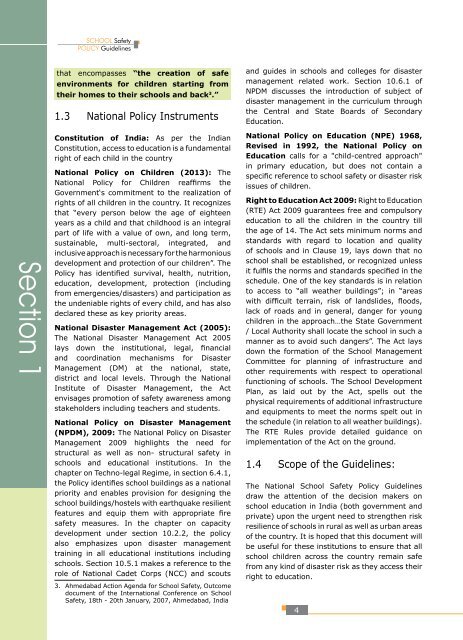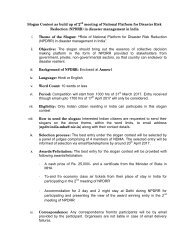National Disaster Management Guidelines School Safety Policy
School-Safety-Policy
School-Safety-Policy
Create successful ePaper yourself
Turn your PDF publications into a flip-book with our unique Google optimized e-Paper software.
SCHOOL <strong>Safety</strong><br />
POLICY <strong>Guidelines</strong><br />
Section 1<br />
that encompasses “the creation of safe<br />
environments for children starting from<br />
their homes to their schools and back 3 .”<br />
1.3 <strong>National</strong> <strong>Policy</strong> Instruments<br />
Constitution of India: As per the Indian<br />
Constitution, access to education is a fundamental<br />
right of each child in the country<br />
<strong>National</strong> <strong>Policy</strong> on Children (2013): The<br />
<strong>National</strong> <strong>Policy</strong> for Children reaffirms the<br />
Government‘s commitment to the realization of<br />
rights of all children in the country. It recognizes<br />
that “every person below the age of eighteen<br />
years as a child and that childhood is an integral<br />
part of life with a value of own, and long term,<br />
sustainable, multi-sectoral, integrated, and<br />
inclusive approach is necessary for the harmonious<br />
development and protection of our children”. The<br />
<strong>Policy</strong> has identified survival, health, nutrition,<br />
education, development, protection (including<br />
from emergencies/disasters) and participation as<br />
the undeniable rights of every child, and has also<br />
declared these as key priority areas.<br />
<strong>National</strong> <strong>Disaster</strong> <strong>Management</strong> Act (2005):<br />
The <strong>National</strong> <strong>Disaster</strong> <strong>Management</strong> Act 2005<br />
lays down the institutional, legal, financial<br />
and coordination mechanisms for <strong>Disaster</strong><br />
<strong>Management</strong> (DM) at the national, state,<br />
district and local levels. Through the <strong>National</strong><br />
Institute of <strong>Disaster</strong> <strong>Management</strong>, the Act<br />
envisages promotion of safety awareness among<br />
stakeholders including teachers and students.<br />
<strong>National</strong> <strong>Policy</strong> on <strong>Disaster</strong> <strong>Management</strong><br />
(NPDM), 2009: The <strong>National</strong> <strong>Policy</strong> on <strong>Disaster</strong><br />
<strong>Management</strong> 2009 highlights the need for<br />
structural as well as non- structural safety in<br />
schools and educational institutions. In the<br />
chapter on Techno-legal Regime, in section 6.4.1,<br />
the <strong>Policy</strong> identifies school buildings as a national<br />
priority and enables provision for designing the<br />
school buildings/hostels with earthquake resilient<br />
features and equip them with appropriate fire<br />
safety measures. In the chapter on capacity<br />
development under section 10.2.2, the policy<br />
also emphasizes upon disaster management<br />
training in all educational institutions including<br />
schools. Section 10.5.1 makes a reference to the<br />
role of <strong>National</strong> Cadet Corps (NCC) and scouts<br />
3. Ahmedabad Action Agenda for <strong>School</strong> <strong>Safety</strong>, Outcome<br />
document of the International Conference on <strong>School</strong><br />
<strong>Safety</strong>, 18th - 20th January, 2007, Ahmedabad, India<br />
and guides in schools and colleges for disaster<br />
management related work. Section 10.6.1 of<br />
NPDM discusses the introduction of subject of<br />
disaster management in the curriculum through<br />
the Central and State Boards of Secondary<br />
Education.<br />
<strong>National</strong> <strong>Policy</strong> on Education (NPE) 1968,<br />
Revised in 1992, the <strong>National</strong> <strong>Policy</strong> on<br />
Education calls for a "child-centred approach"<br />
in primary education, but does not contain a<br />
specific reference to school safety or disaster risk<br />
issues of children.<br />
Right to Education Act 2009: Right to Education<br />
(RTE) Act 2009 guarantees free and compulsory<br />
education to all the children in the country till<br />
the age of 14. The Act sets minimum norms and<br />
standards with regard to location and quality<br />
of schools and in Clause 19, lays down that no<br />
school shall be established, or recognized unless<br />
it fulfils the norms and standards specified in the<br />
schedule. One of the key standards is in relation<br />
to access to “all weather buildings”; in “areas<br />
with difficult terrain, risk of landslides, floods,<br />
lack of roads and in general, danger for young<br />
children in the approach…the State Government<br />
/ Local Authority shall locate the school in such a<br />
manner as to avoid such dangers”. The Act lays<br />
down the formation of the <strong>School</strong> <strong>Management</strong><br />
Committee for planning of infrastructure and<br />
other requirements with respect to operational<br />
functioning of schools. The <strong>School</strong> Development<br />
Plan, as laid out by the Act, spells out the<br />
physical requirements of additional infrastructure<br />
and equipments to meet the norms spelt out in<br />
the schedule (in relation to all weather buildings).<br />
The RTE Rules provide detailed guidance on<br />
implementation of the Act on the ground.<br />
1.4 Scope of the <strong>Guidelines</strong>:<br />
The <strong>National</strong> <strong>School</strong> <strong>Safety</strong> <strong>Policy</strong> <strong>Guidelines</strong><br />
draw the attention of the decision makers on<br />
school education in India (both government and<br />
private) upon the urgent need to strengthen risk<br />
resilience of schools in rural as well as urban areas<br />
of the country. It is hoped that this document will<br />
be useful for these institutions to ensure that all<br />
school children across the country remain safe<br />
from any kind of disaster risk as they access their<br />
right to education.<br />
4



